Abstract
In a prospective study the predictive value of a multivariate morphometric prognostic index was evaluated in 195 patients with primary breast cancer who had not been treated with any form of chemotherapy or hormonal treatment. The presence or absence of distant tumour recurrence combined with the scores of the prognostic index were compared with the survival curves predicted in a previous study. The value of the presence of lymph node metastases, number of positive nodes, tumour size, mitotic activity index, and oestrogen receptor status in prediction of prognosis were also investigated. In agreement with the results of the previous retrospective study, the prospective use of the index had the strongest predictive prognostic value, followed by the mitotic activity index. Statistical analysis showed that the actual prognoses of 43 of the 195 patients (22%) were more accurately determined by the prognostic index rather than by using the presence of the lymph node metastases as the classifying variable. The prognostic index is consistently reproducible by different technicians; it is a reliable method of predicting distant recurrence of tumour and hence the prognosis of patients with primary breast carcinoma. It provides more prognostic information than the presence of lymph node metastases alone, and the index should be incorporated in routine pathology reports.
Full text
PDF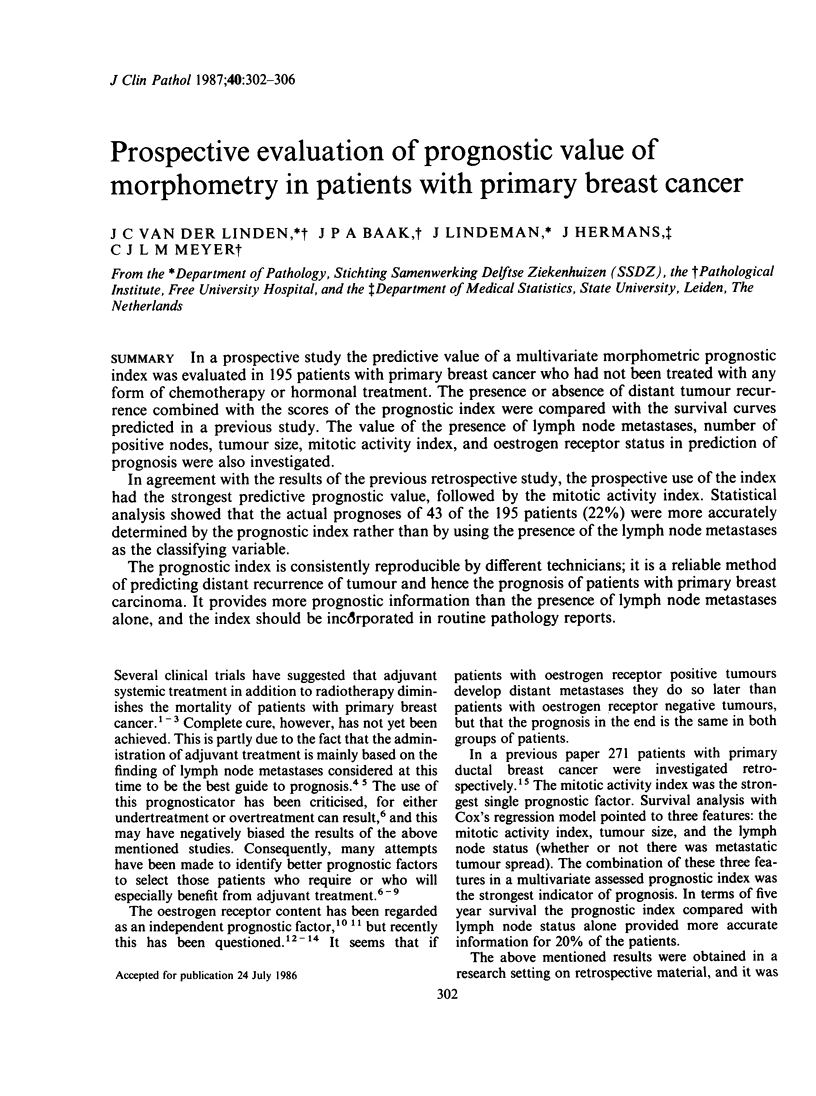
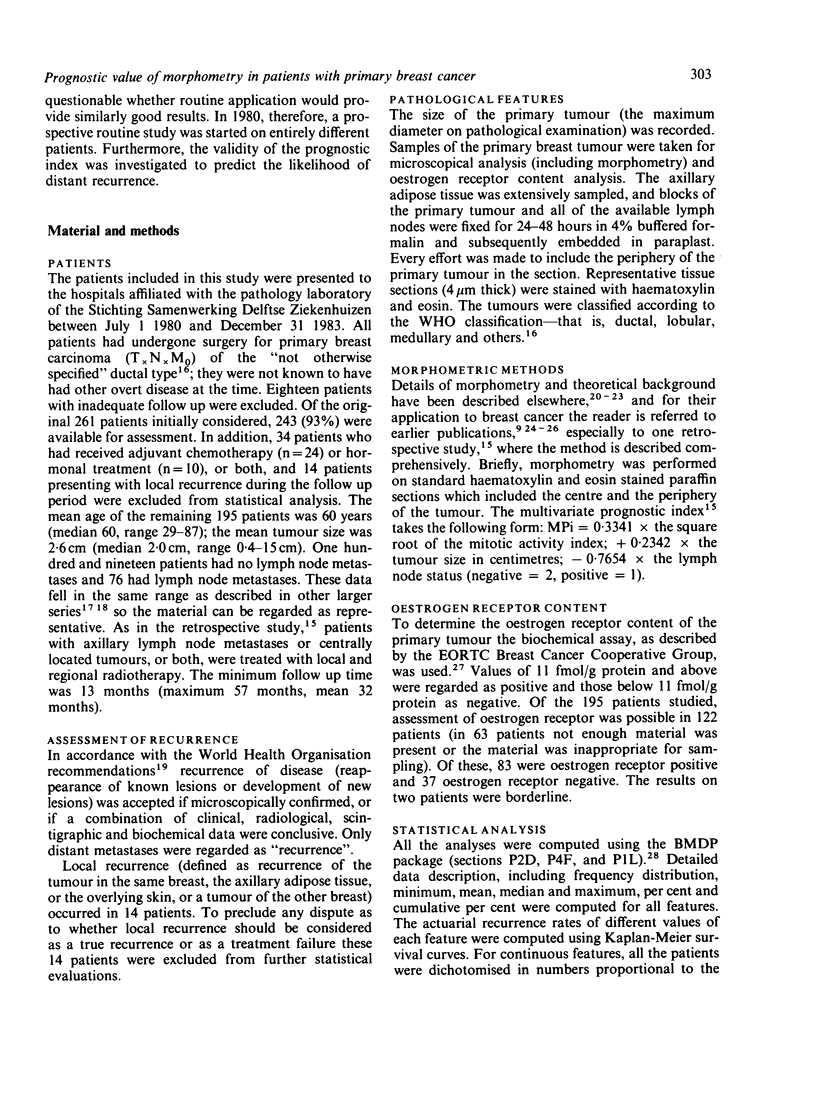
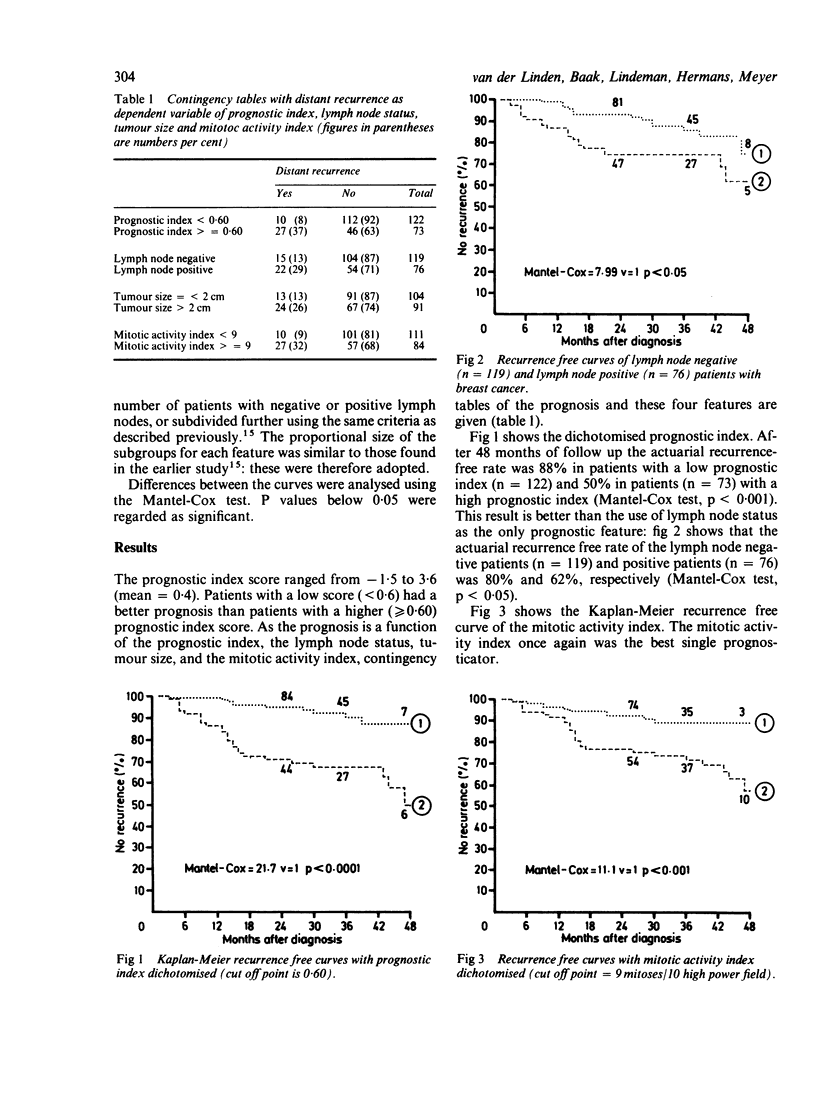
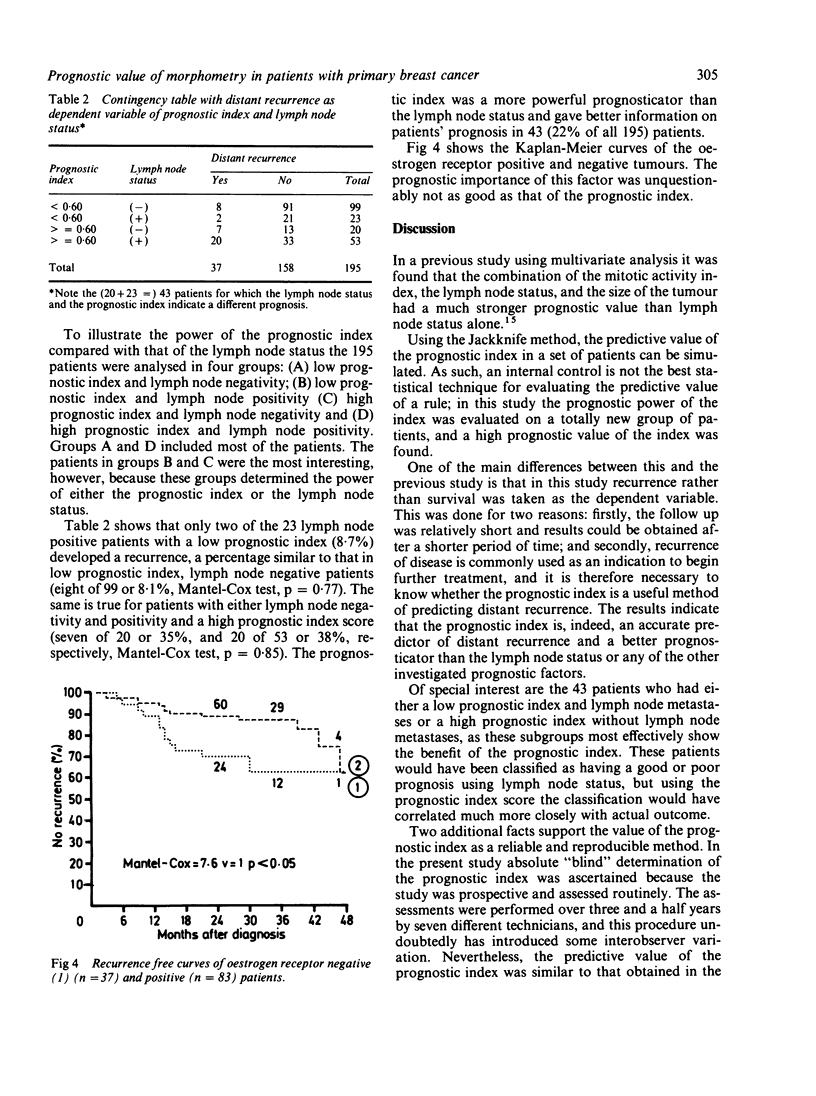
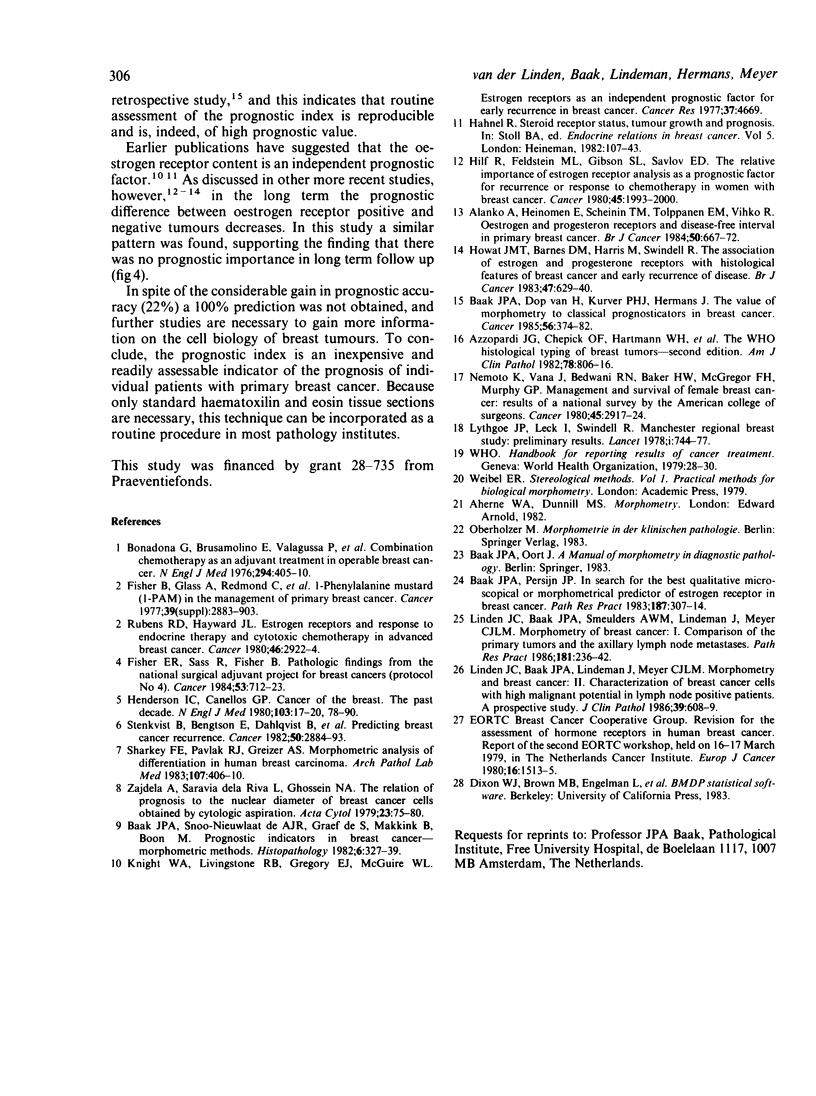
Selected References
These references are in PubMed. This may not be the complete list of references from this article.
- Alanko A., Heinonen E., Scheinin T. M., Tolppanen E. M., Vihko R. Oestrogen and progesterone receptors and disease-free interval in primary breast cancer. Br J Cancer. 1984 Nov;50(5):667–672. doi: 10.1038/bjc.1984.234. [DOI] [PMC free article] [PubMed] [Google Scholar]
- Baak J. P., Kurver P. H., De Snoo-Niewlaat A. J., De Graef S., Makkink B., Boon M. E. Prognostic indicators in breast cancer--morphometric methods. Histopathology. 1982 May;6(3):327–339. doi: 10.1111/j.1365-2559.1982.tb02727.x. [DOI] [PubMed] [Google Scholar]
- Baak J. P., Van Dop H., Kurver P. H., Hermans J. The value of morphometry to classic prognosticators in breast cancer. Cancer. 1985 Jul 15;56(2):374–382. doi: 10.1002/1097-0142(19850715)56:2<374::aid-cncr2820560229>3.0.co;2-9. [DOI] [PubMed] [Google Scholar]
- Bonadonna G., Brusamolino E., Valagussa P., Rossi A., Brugnatelli L., Brambilla C., De Lena M., Tancini G., Bajetta E., Musumeci R. Combination chemotherapy as an adjuvant treatment in operable breast cancer. N Engl J Med. 1976 Feb 19;294(8):405–410. doi: 10.1056/NEJM197602192940801. [DOI] [PubMed] [Google Scholar]
- Fisher B., Glass A., Redmond C., Fisher E. R., Barton B., Such E., Carbone P., Economou S., Foster R., Frelick R. L-phenylalanine mustard (L-PAM) in the management of primary breast cancer. An update of earlier findings and a comparison with those utilizing L-PAM plus 5-fluorouracil (5-FU). Cancer. 1977 Jun;39(6 Suppl):2883–2903. doi: 10.1002/1097-0142(197706)39:6<2883::aid-cncr2820390676>3.0.co;2-9. [DOI] [PubMed] [Google Scholar]
- Fisher E. R., Sass R., Fisher B. Pathologic findings from the National Surgical Adjuvant Project for Breast Cancers (protocol no. 4). X. Discriminants for tenth year treatment failure. Cancer. 1984 Feb 1;53(3 Suppl):712–723. doi: 10.1002/1097-0142(19840201)53:3+<712::aid-cncr2820531320>3.0.co;2-i. [DOI] [PubMed] [Google Scholar]
- Henderson I. C., Canellos G. P. Cancer of the breast: the past decade (first of two parts). N Engl J Med. 1980 Jan 3;302(1):17–30. doi: 10.1056/NEJM198001033020104. [DOI] [PubMed] [Google Scholar]
- Hilf R., Feldstein M. L., Gibson S. L., Savlov E. D. The relative importance of estrogen receptor analysis as a prognostic factor for recurrence or response to chemotherapy in women with breast cancer. Cancer. 1980 Apr 15;45(8):1993–2000. doi: 10.1002/1097-0142(19800415)45:8<1993::aid-cncr2820450802>3.0.co;2-2. [DOI] [PubMed] [Google Scholar]
- Howat J. M., Barnes D. M., Harris M., Swindell R. The association of cytosol oestrogen and progesterone receptors with histological features of breast cancer and early recurrence of disease. Br J Cancer. 1983 May;47(5):629–640. doi: 10.1038/bjc.1983.101. [DOI] [PMC free article] [PubMed] [Google Scholar]
- Knight W. A., Livingston R. B., Gregory E. J., McGuire W. L. Estrogen receptor as an independent prognostic factor for early recurrence in breast cancer. Cancer Res. 1977 Dec;37(12):4669–4671. [PubMed] [Google Scholar]
- Lythgoe J. P. Manchester regional breast study. Preliminary results. Lancet. 1978 Apr 8;1(8067):744–747. doi: 10.1016/s0140-6736(78)90859-0. [DOI] [PubMed] [Google Scholar]
- Nemoto T., Vana J., Bedwani R. N., Baker H. W., McGregor F. H., Murphy G. P. Management and survival of female breast cancer: results of a national survey by the American College of Surgeons. Cancer. 1980 Jun 15;45(12):2917–2924. doi: 10.1002/1097-0142(19800615)45:12<2917::aid-cncr2820451203>3.0.co;2-m. [DOI] [PubMed] [Google Scholar]
- Rubens R. D., Hayward J. L. Estrogen receptors and response to endocrine therapy and cytotoxic chemotherapy in advanced breast cancer. Cancer. 1980 Dec 15;46(12 Suppl):2922–2924. doi: 10.1002/1097-0142(19801215)46:12+<2922::aid-cncr2820461435>3.0.co;2-d. [DOI] [PubMed] [Google Scholar]
- Sharkey F. E., Pavlak R. J., Greiner A. S. Morphometric analysis of differentiation in human breast carcinoma. Tumor grading. Arch Pathol Lab Med. 1983 Aug;107(8):406–410. [PubMed] [Google Scholar]
- Stenkvist B., Bengtsson E., Dahlqvist B., Eklund G., Eriksson O., Jarkrans T., Nordin B. Predicting breast cancer recurrence. Cancer. 1982 Dec 15;50(12):2884–2893. doi: 10.1002/1097-0142(19821215)50:12<2884::aid-cncr2820501231>3.0.co;2-k. [DOI] [PubMed] [Google Scholar]
- The world Health Organization Histological Typing of Breast Tumors--Second Edition. The World Organization. Am J Clin Pathol. 1982 Dec;78(6):806–816. doi: 10.1093/ajcp/78.6.806. [DOI] [PubMed] [Google Scholar]
- Van der Linden H. C., Baak J. P., Smeulders A. W., Lindeman J., Meyer C. J. Morphometry of breast cancer. I. Comparison of the primary tumours and the axillary lymph node metastases. Pathol Res Pract. 1986 May;181(2):236–242. doi: 10.1016/S0344-0338(86)80016-4. [DOI] [PubMed] [Google Scholar]
- Zajdela A., De LaRiva L. S., Ghossein N. A. The relation of prognosis to the nuclear diameter of breast cancer cells obtained by cytologic aspiration. Acta Cytol. 1979 Jan-Feb;23(1):75–80. [PubMed] [Google Scholar]


